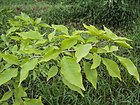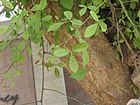Note: This is a project under development. The articles on this wiki are just being initiated and broadly incomplete. You can Help creating new pages.
Difference between revisions of "Aegle marmelos - Bilva"
(→Identification) |
(→Commonly seen growing in areas) |
||
| Line 57: | Line 57: | ||
==Commonly seen growing in areas== | ==Commonly seen growing in areas== | ||
| − | {{Commonly seen| | + | {{Commonly seen|Tropical region}}, {{Commonly seen|Temperate region}}. |
==Photo Gallery== | ==Photo Gallery== | ||
Revision as of 13:01, 26 September 2018
Bilva consists of pulp of entire, unripe or half ripe fruits of Aegle marmelos Carr. (Fam. Rutaceae), a tree, attaining a height of 12 m growing wild and also cultivated throughout the country, rind of fruit is removed and pulp is bruised and dried[1]
Contents
- 1 Uses
- 2 Parts Used
- 3 Chemical Composition
- 4 Common names
- 5 Properties
- 6 Habit
- 7 Identification
- 8 List of Ayurvedic medicine in which the herb is used
- 9 Where to get the saplings
- 10 Mode of Propagation
- 11 How to plant/cultivate
- 12 Commonly seen growing in areas
- 13 Photo Gallery
- 14 References
- 15 External Links
Uses
Fever, Nasal bleeding, Diarrhoea, Skin disease, Intestinal worms, Cough, Diabetes, Vomiting, Cough, Stomachache, Infection in intestine.
Parts Used
Chemical Composition
Marmalosin, tannins, mucilage, fatty oil and sugar.[2]
Common names
| Language | Common name |
|---|---|
| Kannada | Bilva |
| Hindi | Bela, Sriphal, Bel |
| Malayalam | Koovalam |
| Tamil | Vilvam |
| Telugu | Maredu |
| Marathi | Bel, Baela |
| Gujarathi | Bill, Bilum, Bilvaphal |
| Punjabi | Bil |
| Kashmiri | Bel |
| Sanskrit | Shreephala |
| English | Bengal Quince, Bael fruit |
Properties
Reference: Dravya - Substance, Rasa - Taste, Guna - Qualities, Veerya - Potency, Vipaka - Post-digesion effect, Karma - Pharmacological activity, Prabhava - Therepeutics.
Dravya
Rasa
Katu (Pungent), Tikta, Kashaya
Guna
Laghu (Light), Ruksha (Dry)
Veerya
Ushna (heat)
Vipaka
Katu (Pungent)
Karma
Balya, Deepana, Grahya, Paacana
Prabhava
Habit
Identification
Leaf
| Kind | Shape | Feature |
|---|---|---|
| alternate | trifoliate | Each leaflet 5-14 x 2–6 cm, ovate with tapering or pointed tip and rounded base, untoothed or with shallow rounded teeth. Young leaves are pale green or pinkish. |
Flower
| Type | Size | Color and composition | Stamen | More information |
|---|---|---|---|---|
| bisexual | 1.5 to 2 cm | pale green or yellowish | The four or five petals of 6–8 mm overlap in the bud and The ovary is bright green with an inconspicuous disc |
Fruit
| Type | Size | Mass | Appearance | Seeds | More information |
|---|---|---|---|---|---|
| globose or slightly pear-shaped | The bael fruit typically has a diameter of between 5 and 12 cm | many | Fruiting on summer and winter |
Other features
List of Ayurvedic medicine in which the herb is used
Where to get the saplings
Mode of Propagation
How to plant/cultivate
Commonly seen growing in areas
Tropical region, Temperate region.
Photo Gallery
References
External Links
- Ayurvedic Herbs known to be helpful to treat Fever
- Ayurvedic Herbs known to be helpful to treat Nasal bleeding
- Ayurvedic Herbs known to be helpful to treat Diarrhoea
- Ayurvedic Herbs known to be helpful to treat Skin disease
- Ayurvedic Herbs known to be helpful to treat Intestinal worms
- Ayurvedic Herbs known to be helpful to treat Cough
- Ayurvedic Herbs known to be helpful to treat Diabetes
- Ayurvedic Herbs known to be helpful to treat Vomiting
- Ayurvedic Herbs known to be helpful to treat Stomachache
- Ayurvedic Herbs known to be helpful to treat Infection in intestine
- Herbs with Seeds used in medicine
- Herbs with Leaves used in medicine
- Herbs with common name in Kannada
- Herbs with common name in Hindi
- Herbs with common name in Malayalam
- Herbs with common name in Tamil
- Herbs with common name in Telugu
- Herbs with common name in Marathi
- Herbs with common name in Gujarathi
- Herbs with common name in Punjabi
- Herbs with common name in Kashmiri
- Herbs with common name in Sanskrit
- Herbs with common name in English
- Habit - Tree
- Index of Plants which can be propagated by Seeds
- Herbs that are commonly seen in the region of Tropical region
- Herbs that are commonly seen in the region of Temperate region
- Herbs





